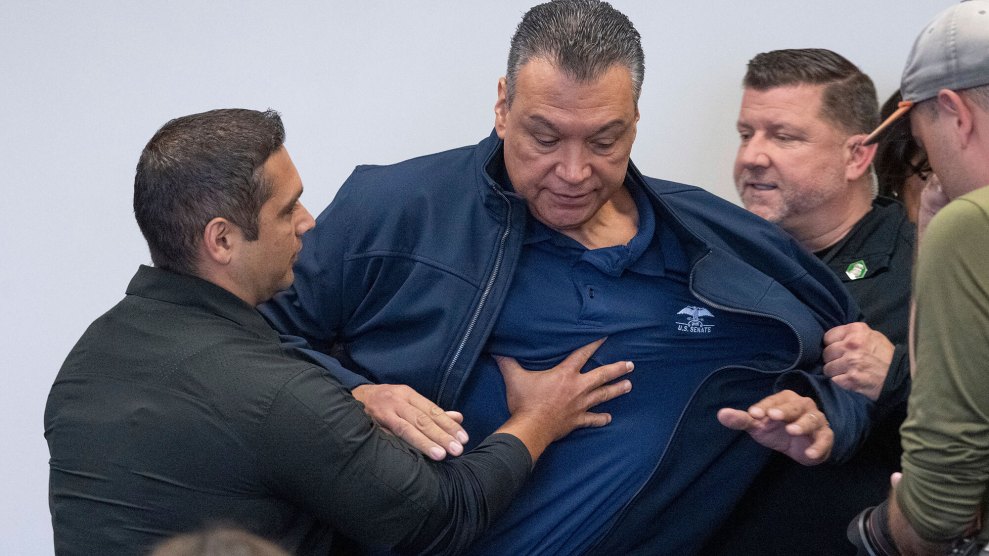AT NORTH CAROLINA’S Fort Bragg this February, Army Special Forces trainee Richard Corcoran got mad at his estranged wife, Michele. He’d gotten mad before, but this would mark the sixth and final time the Cumberland County Sheriffs Department would be called to break up a “domestic disturbance” between Corcoran and his wife. At 8:30 p.m. Corcoran arrived at his wife’s house and went after 30-year-old Michele with a gun, firing at her as she fled to a neighbor’s. (She was wounded but survived.) He shot and wounded another Fort Bragg soldier who was in the house and then shot and killed himself—all while his seven-month-old daughter lay in another room.
He joins a band of brothers. Corcoran’s is the 10th fatality in a slew of domestic violence homicides involving Fort Bragg soldiers since 2002; in one six-week spree four Army wives were murdered by their husbands or ex-husbands. Including nonfatal incidents, there were 832 victims of domestic violence between 2002 and 2004 at Fort Bragg alone, according to Army figures.
And yet Corcoran’s attack stands out. Not only had he just attended a mandated anger-management class on-post that same afternoon—calling into question the efficacy of these sessions that the Army considers the cornerstone of its domestic violence treatment program—but Corcoran had a past that should have kept him out of the Army in the first place: He had been indicted for rape at the age of 19.
On March 1, 1989, in the town of Glen Ridge, New Jersey, Corcoran and six other high school athletes sexually assaulted a retarded girl with sticks and a baseball bat. Corcoran, like all the boys, admitted being present but insisted he just watched. Four of the boys were tried and convicted in a grueling five-month trial. Three days before Corcoran’s trial was slated to begin in 1994, the victim’s parents decided it was not in their daughter’s best interest to pursue another trial. The case against Corcoran, son of a Glen Ridge police lieutenant, was dropped.
Several years later, Richard Corcoran joined the Army.
THE MILITARY HAS A DOMESTIC violence problem—or, as the Army calls it, a “spousal aggression issue.” Sometimes, when soldiers have just returned from a war zone—like Corcoran, who had spent eight months in Afghan- istan—the media speculates that post-traumatic stress may be to blame. This seems somewhat specious. The Defense Department doesn’t break down pre- and post-deployment figures, but the fact is that rates of domestic violence in the military have been high for years—two to five times higher than among civilians, depending on which study is consulted.
In the 1990s, the military quietly watched as its domestic violence rates shot up from 19 per 1,000 soldiers in 1990 to 26 per 1,000 soldiers in 1996. After three soldiers stationed at Kentucky’s Fort Campbell were charged with killing their wives or girlfriends, an alarmed Congress appointed a task force to investigate and make recommendations. Last year, according to DoD figures, there were 16,400 cases of domestic violence reported, with 9,450 of them substantiated. That’s still a rate of 14 cases for every 1,000 couples, compared with 3 per 1,000 among civilians. And consider that many soldiers spent all or part of last year deployed and thus physically separated from their spouses.
The military admits it has a problem but points out that its population is disproportionately young and poor—and, statistically, domestic violence is higher among such civilians, too. (Whether that’s because the young and poor—more likely to come into contact with the system via shelters, social services, and the courts—are just overcounted is hotly contested among experts.)
Meanwhile, domestic violence advocates assert that the military’s numbers are even higher than the DoD says. If military spouses live off-post—as 60 percent do—and call the local cops or shelter for help, they might not show up in the military’s statistics. Further, the military defines domestic violence narrowly: It has only counted incidents against a current, legal spouse—and half the 1.5 million enlisted soldiers are unmarried, divorced, living with girlfriends, dating, or busy “not asking or telling.”
Twenty years ago when the military did its domestic violence training, it was not unusual to call it a “relationship issue” and hand it over to therapists to sort out. Even today, batterers in the military are typically ordered into anger-management classes and couples counseling—both considered largely ineffective by most civilian experts.
“These anger-treatment models are not very successful because this is not an illness, it’s an attitude. It’s about people feeling like they’re entitled to do this to their wives,” says attorney Juley Fulcher, who worked on the issue for years at the National Coalition Against Domestic Violence. “The day you start seeing these guys go after their commanding officer because they’re pissed off and they can’t control their anger, we’ll rethink our theory,” she adds.
According to Deborah Tucker, who heads the National Center on Domestic and Sexual Violence in Austin, Texas, and cochaired the Defense Task Force on Domestic Violence, the military is making progress on the issue. In 2003, it agreed to adopt 194 of the task force’s 200 recommendations to improve services for victims and beef up offender accountability. Still, two years later many have yet to be implemented and that troubles her, though she adds that “some argue that what’s been done already is much faster than usual [for the military].”
Meanwhile, the military faces new scandals over sexual harassment in its ranks, rape at the Air Force Academy, and reports on the high numbers of sexual assaults against its female soldiers. These are behaviors that exist on a continuum with domestic violence, explains Tucker. “To eradicate domestic violence in the military—and the United States of America—will take a cultural shift that condemns violence as criminal behavior and does not excuse it because of the comportment of the victim, the alcohol or drug abuse of the offender, the stress the offender is under, or even how sorry the offender is afterwards,” says Tucker. She insists that military brass must lead the charge if change is to trickle down from the base commanders to the recruiters trawling the local mall.
FOR EVIDENCE that this has yet to happen, one need only consider Richard Corcoran’s career trajectory. Army recruiters might have suggested that even if the teenage Corcoran had just watched the assault in the basement on that winter day in Glen Ridge—as so many soldiers at Abu Ghraib apparently also just “watched”—the fact that he did nothing to stop it is not in keeping with core Army values of honor and integrity. Call it a tip-off that this prospective soldier lacked respect for women—and perhaps the law.
But maybe the Army didn’t know about the rape?
“Sure they knew,” says Essex County prosecutor Robert Laurino, who tried the first Glen Ridge case. One recruiter even came to meet with Laurino. “Are you aware of this fellow and what his background is?” Laurino recalls asking, shocked that the Army was recruiting Corcoran.
“Yes,” the recruiter told Laurino. “That’s just the kind of guy we want to turn into a man.”
















